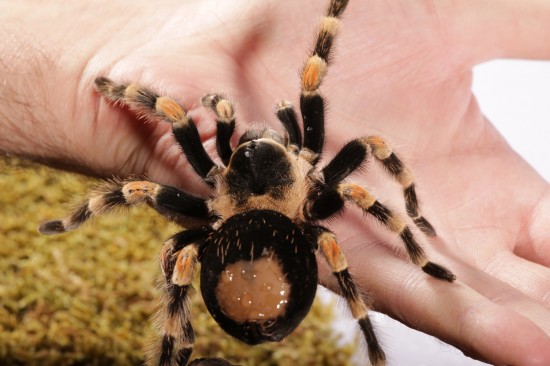

One simple fact that all prospective tarantula owners should be aware of is that it can be very difficult to get veterinary treatment for spiders! Unlike cats, dogs and other small pets, if you need help or advice with your tarantula, you will not be able to simply pop it along to the nearest veterinary practice to seek treatment.
General practice veterinary surgeons receive only cursory training in the care and handling of exotic pets, and when you consider how many species of animals there are altogether, it is understandable that standard veterinary training concentrates only on the most commonly found mainstream animals that live within the UK.
This is not to say that it is impossible to seek veterinary treatment for a tarantula, but it certainly often difficult to do so! You may have to travel some distance to find a specialist vet that is experienced and willing to treat exotic pets and venomous spiders in particular, or even have to look to other sources of help, such as professional arachnid keepers with private collections or that work within a zoo environment, or other experienced tarantula owners and enthusiasts.
This makes it all the more important to ensure that your pet tarantula is kept in the optimum living environment for good health, to minimise the likelihood of any problems occurring in the first place.
In this article, we will cover the most common threats to tarantula health and wellness, plus some advice on how to deal with common problems.
Tarantulas, while delicate, are generally fairly hardy animals, and provided that they are not dropped, exposed to predators or kept in poor conditions, will generally self-regulate their health and wellness without the need for external intervention.
The most common risks to the health of pet tarantulas are caused by falling or being dropped, or due to dehydration from an environment that is not humid enough to fulfil their needs.
Tarantulas acquire most of their water intake needs from their food, and you may often go for some time without seeing your tarantula drinking. Nevertheless, providing a water dish is essential, and the water within it should be clean, fresh and changed regularly. As well as providing for the tarantula’s need to drink, over time, the water within their dish will evaporate, providing necessary humidity within the tank. You may also need to lightly spray the substrate of the tank with fresh water regularly to ensure that the atmosphere is humid enough.
A tarantula that hovers or stands over its water dish without drinking is probably being subjected to an environment that is too dry, and is attempting to hydrate itself by standing over the water.
A tarantula that is dehydrated will over time become more lethargic and less active. The size and shape of the abdomen may well shrink as well, and eventually they may take on a hunched up appearance with the legs curled underneath the body. If your tarantula is dehydrated to this extent, you will need to act to correct the problem before it progresses any further.
You can create a simple tarantula humidifier by using a small Tupperware or margarine tub with tiny holes poked in the lid for ventilation, containing water-saturated paper towels in the base of it. Place your tarantula in this tub and close the lid, then place the tub somewhere warm but not too hot, in order to allow the water in the tub to evaporate in the air.
Your tarantula’s condition should improve significantly within 24 hours, and meanwhile you should use this time to address the issue of the water content and humidity within their enclosure, considering the temperature, water provision and substrate.
If your tarantula falls, catches a limb on something or otherwise becomes injured, they will bleed a clear or yellowish liquid from the wound. Tarantulas do not have a lot of blood to lose in the first place, and so any amount of blood loss can be dangerous to them. Fortunately, healing an external wound on a tarantula is simply achieved with the use of a specialist skin adhesive glue, or even in an emergency, superglue! This quickly repairs ruptures and tears in the skin, and halts dangerous blood loss.
Losing a leg is understandably a fairly serious business, but when you have eight legs to start with, need not be the end of the world! Sometimes, a tarantula will lose a leg after an injury or accident, or even potentially as a side effect of a difficult moult.
If your tarantula loses a leg and is left with a bleeding wound, use skin adhesive to stop the bleeding. Your tarantula should in time then regenerate the missing limb in their next moult, although the new leg may potentially initially be smaller and balder than the original legs!
It is important to remember that as with any animal (or person) illness, pain or discomfort can lead to grouchiness and defensive aggression. Not only will they be more delicate and prone to further injury from handling, but even the most laid back of spiders will be exponentially more likely to bite or attack defensively.
Handle your tarantula with extreme care if attempting any form of care for them, and always wear gloves. A handy trick to remember is that spiders become lethargic and sluggish in the cold, so placing your tarantula in a small container in the fridge for a short while before attempting to handle them can make things somewhat safer and easier.
 Feeding Wild Birds During The Winter
Feeding Wild Bird
Feeding Wild Birds During The Winter
Feeding Wild Bird
 Assessing The Potential Buyers Of Your Pedigree Puppies
Assessing The Pot
Assessing The Potential Buyers Of Your Pedigree Puppies
Assessing The Pot
 Dogs And Car Trips - Why Do They Love Sticking Their Nose Out Of The Window?
Dogs And Car Trip
Dogs And Car Trips - Why Do They Love Sticking Their Nose Out Of The Window?
Dogs And Car Trip
 Walking A Reluctant Dog
Walking A Relucta
Walking A Reluctant Dog
Walking A Relucta
 Puppy Farms - How And Why To Avoid Buying A Farmed Puppy
Puppy Farms - How
Puppy Farms - How And Why To Avoid Buying A Farmed Puppy
Puppy Farms - How
Copyright © 2005-2016 Pet Information All Rights Reserved
Contact us: www162date@outlook.com